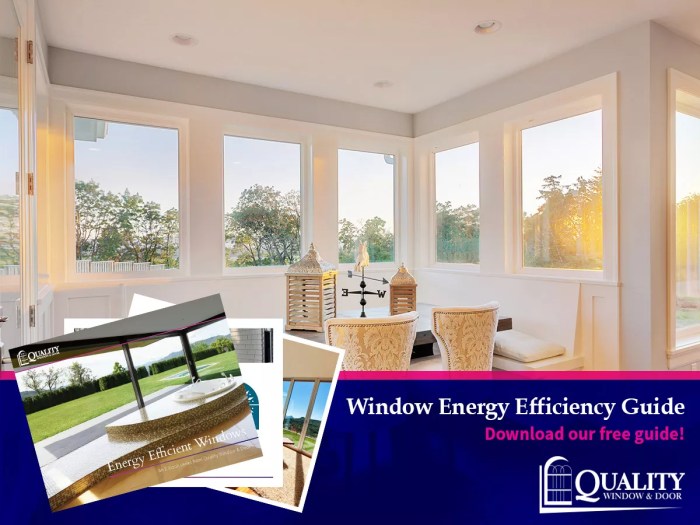Exploring the realm of energy efficiency within homes, this article delves into the pivotal role that new windows play in enhancing sustainability and reducing energy consumption. By understanding the importance of upgrading windows, homeowners can make informed decisions that benefit both the environment and their wallets.
Importance of Energy Efficiency
Energy efficiency is crucial in homes to reduce energy consumption, lower utility bills, and minimize the environmental impact of excessive energy use. By improving energy efficiency, homeowners can create a more sustainable living environment while also enhancing the comfort and quality of their homes.
Benefits of Improving Energy Efficiency
- Lower Utility Bills: Improving energy efficiency in homes can lead to significant savings on heating and cooling costs throughout the year.
- Reduced Environmental Impact: Decreasing energy consumption helps reduce greenhouse gas emissions and minimize the overall carbon footprint of a household.
- Enhanced Comfort: Proper insulation and energy-efficient windows can help maintain consistent indoor temperatures, creating a more comfortable living space.
- Increased Home Value: Energy-efficient features are attractive to potential buyers and can increase the resale value of a home.
Role of Windows in Energy Conservation
Windows play a crucial role in energy conservation by preventing heat loss in the winter and minimizing heat gain in the summer. Energy-efficient windows are designed to provide better insulation, reduce air leakage, and block harmful UV rays, helping homeowners maintain a comfortable indoor environment while using less energy for heating and cooling.
Features of Energy-Efficient Windows
Energy-efficient windows are designed with specific features that help in reducing energy consumption and improving overall efficiency.
Key Features
- Low-E Coatings: These coatings help in reflecting heat back into the room during winter and blocking it out during summer.
- Multi-Pane Glass: Double or triple-pane glass windows provide better insulation and reduce heat transfer.
- Gas Fills: Inert gases like argon or krypton between window panes improve insulation properties.
- Warm Edge Spacers: These spacers reduce heat transfer around the edges of the window.
- Insulated Frames: Materials like fiberglass, vinyl, or wood with thermal breaks prevent heat loss.
Materials Used
Energy-efficient windows are made using various materials that contribute to their effectiveness in conserving energy.
| Material | Properties |
|---|---|
| Fiberglass | Strong, durable, and low thermal conductivity. |
| Vinyl | Low maintenance, good insulation, and cost-effective. |
| Wood with Thermal Breaks | Natural look, excellent insulation, and eco-friendly. |
Comparison with Traditional Windows
When compared to traditional windows, energy-efficient windows offer significant advantages in terms of energy savings and comfort.
Traditional windows allow heat transfer, leading to energy loss and higher utility bills.
Energy-efficient windows provide better insulation, reducing heat transfer and energy consumption.
How New Windows Enhance Insulation
When it comes to improving energy efficiency, one of the key aspects is enhancing insulation in windows. New windows play a crucial role in this by providing better sealing and insulation compared to older, inefficient windows.
Types of Insulation Techniques Used in Windows
- Double or Triple Glazing: This technique involves two or three panes of glass with a layer of air or gas in between. It helps to reduce heat transfer and improve insulation.
- Low-E Coatings: Low-emissivity coatings are applied to the glass surface to reflect heat back into the room, reducing heat loss through the windows.
- Insulated Frames: Windows with insulated frames, such as vinyl or fiberglass, prevent heat transfer and improve overall energy efficiency.
- Weather Stripping: Proper weather stripping helps seal any gaps or cracks around the window frame, preventing air leaks and improving insulation.
Window Design and Orientation
When it comes to energy efficiency, the design and orientation of windows play a crucial role in maximizing insulation and reducing heat transfer. By utilizing specific window designs and properly orienting them, homeowners can significantly improve the overall energy efficiency of their homes.
Impact of Window Design
Window design directly affects energy efficiency by determining factors such as the amount of natural light entering the space, as well as heat gain and loss. Features like double or triple panes, low-emissivity coatings, and gas fills can all enhance insulation properties and reduce energy consumption.
Significance of Proper Window Orientation
The orientation of windows in a home is essential for maximizing natural light and heat gain based on the sun's position throughout the day. South-facing windows receive the most sunlight, making them ideal for capturing solar heat during colder months, while east and west-facing windows can provide natural light without excessive heat gain when properly designed.
Examples of Energy-Efficient Window Designs
- Double or Triple Pane Windows: Multiple layers of glass with insulating gas fills between them to reduce heat transfer.
- Low-E Coatings: Thin coatings on window glass that reflect infrared heat while allowing visible light to pass through, improving insulation.
- Gas-Filled Windows: Windows filled with insulating gases like argon or krypton to reduce heat transfer and improve overall energy efficiency.
- Insulated Frames: Window frames made from materials like vinyl, fiberglass, or wood composite that provide better insulation and reduce energy loss.
Conclusive Thoughts

In conclusion, the integration of energy-efficient windows not only enhances the aesthetic appeal of a home but also contributes significantly to reducing energy costs and environmental impact. By embracing these advancements in window technology, individuals can create a more sustainable and eco-friendly living space.
Helpful Answers
How much can energy-efficient windows reduce energy costs?
Energy-efficient windows can reduce energy costs by up to 20% annually, depending on various factors such as climate and home size.
Are there government incentives for installing energy-efficient windows?
Yes, there are often tax credits and rebates available for homeowners who choose to install energy-efficient windows as part of their home improvement projects.
Do energy-efficient windows help in noise reduction as well?
Yes, energy-efficient windows with proper insulation can also significantly reduce noise from the outside, providing a quieter and more peaceful indoor environment.


![5 Best Field Service Management Software [2025]](https://ae.goodstats.id/wp-content/uploads/2025/09/38877ff56f11b8e71045b45896b02652-350x250.jpg)








